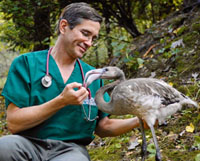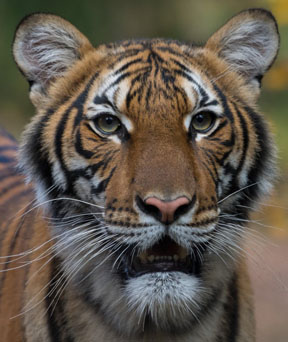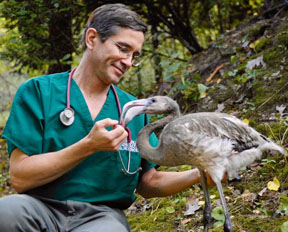
Nadia 288

Wildlife Conservation Society photo by Julie Larsen Maher
Nadia, a 200-pound tiger at the Bronx Zoo, was the first nonhuman animal in the United States with a documented case of COVID-19. The zoo has since confirmed that a total of eight of its animals — Malayan tigers, Amur tigers and African lions — are positive for the novel coronavirus.
On March 27, a keeper at the Bronx Zoo noticed that one of the animals, a 4-year-old Malayan tiger named Nadia, was coughing. Over the course of the next week, three more tigers in the same facility and three lions in a separate facility developed coughs, too. Some also wheezed.
As Nadia's coughing continued and her appetite waned, the zoo veterinary and animal teams determined a closer look was warranted. On April 2, the 200-pound tiger was anesthetized for an exam and diagnostic workup — X-rays, ultrasound and blood work. The veterinary team collected samples for a routine feline respiratory panel. They also took nasal, oropharyngeal and tracheal samples for an assay that is not routine: a test for the virus that causes COVID-19.
Three days later, the zoo posted an announcement that Nadia was positive for the virus, SARS-CoV-2. She is the first documented nonhuman patient in the United States with COVID-19.
On Wednesday, the zoo posted a news release that the three lions and three tigers that became sick around the same time as Nadia, along with one tiger that never appeared sick, had also tested positive for the virus, making for a total of eight positive zoo inhabitants. The new results were derived from a fecal-sample test that did not require anesthetizing the big cats. The sick animals were said to be all recovering well.
The VIN News Service spoke this week with Dr. Paul Calle, chief veterinarian of the Bronx Zoo. The questions and answers that follow are derived from two telephone conversations and subsequent email communications.
At what point did you suspect Nadia and the others might have COVID-19?
In the face of what's going on in people in New York City, as the epicenter of the U.S. COVID pandemic now, we of course considered that as one of the possible causes of illness. We had been in touch with veterinary labs at the University of Illinois and Cornell University and the state veterinarian, and made sure we collected the samples that the labs could use for this test. We went into the anesthesia and workup with the intention of testing for that.
Walk us through the process of obtaining a tiger test for COVID-19. Whom did you have to call?
Cornell, certainly, they have great resources there for feline infectious diseases. We've used them before for other testing in other animals. And we have close relationships with the University of Illinois lab. So we have [established] relationships with both.
Every lab in the country that wants to perform the COVID test in an animal has to have the state veterinarian's approval for sample submission. So that was part of the process.
It went efficiently?
Dr. Paul Calle 288

Wildlife Conservation Society photo by Julie Larsen Maher
Dr. Paul Calle, shown with a juvenile flamingo, is chief veterinarian of the Bronx Zoo, where he has worked since 1989. The zoo is operated by the Wildlife Conservation Society, which was founded 125 years ago as the New York Zoological Society. Because of the COVID-19 pandemic, the zoo has been closed to the public since March 16.
Yes, everyone was great partners. City, state, federal, animal and human health agencies and the veterinary schools all worked closely together. It really was seamless communications.
Some people have wondered how a tiger could get a COVID-19 test when many people could not. Can you address that?
Veterinary samples go to a veterinary lab, and human samples go to a human lab. Our testing of Nadia did not take away from any human testing.
All of the testing is for SARS-CoV-2-specific RNA [using a technique known as polymerase chain reaction, or PCR]. In that way, they're all looking for the same thing. However, both the genome targets and the reagents used can be different between the tests. There has been an emphasis in the veterinary diagnostic community to develop assays that would not use the same reagents as are used in the human tests, and also the swab we use was not the same swab that is used in the human testing. Tiger nares are a little bit bigger than a person's.
"Did you use the same test?" is such a simple question with such a complicated answer.
It's presumed that the tigers and lions caught the virus from a zoo employee but you don't know who that is, is that correct?
That's correct. No one was sick when they were at work. We have pretty strict policies in place: if you're sick, don't come to work. We don't want to get each other sick.
But there's a lot of COVID in people in New York City. There's a high percentage of infected people who shed virus and never develop any symptoms, or shed and only develop mild illness, so we're assuming it had to be that kind of situation. But there's no one person who we suspect.
Have any Bronx Zoo employees tested positive for COVID-19 or had symptoms indicative of COVID-19?
I don't know. The New York City Department of Health and our zoo nurse practitioner are responsible for employee health and that information, not the veterinarians.
Can we be certain that there wasn't transmission between the cats?
The only source of COVID was people. We do not have any information about cat-to-cat transmission at this time. We know that COVID is very common in people in New York City right now, so that was the source — a zoo employee — and, again, we don't know who that is. That part is one of the many things that are still being looked into by the appropriate people.
How close do zoo employees get to the tigers and lions?
We do not go in with dangerous animals like lions and tigers, but in the course of routine care, feeding, enrichment, etc., staff can be in close proximity, although there is always a barrier between you and them. You never directly go in with them.
The zoo provided a link to an Animal Planet video that includes footage of the tiger enclosure.
How close to one another were the tigers and lions that got sick?
There is a facility that the five tigers lived in. They live separately; they're a solitary species. So there were five tigers in one building. Four of those five developed a cough and wheezing over that week. One of them, a male, never developed any clinical signs.
In a separate building are three African lions. All three of them developed similar clinical signs. The lions are sometimes together.
Describe the process of recovery. Did any of the animals require medication?
Some were put on antibiotics out of concern for a secondary bacterial infection. We gave some anti-nausea medications and anti-inflammatories. None of them got very sick and all have done very well.
The zoo's most recent press release says that "none of the zoo's snow leopards, cheetahs, clouded leopard, Amur leopard, puma or serval are showing any signs of illness." Does the zoo have any other tigers or lions that likewise have not appeared to be ill?
No other animals at the zoo are suspected to have COVID infection, including three tigers that live in another area of the zoo.
Any concerns about other species being susceptible, such as primates?
Our original concern was about the risk of COVID transmission to gorillas and other nonhuman primates. We've always had preventive protocols for our nonhuman primates — masks, gloves, things like that, to guard against transmission of cold viruses, influenza, herpes virus .... That's part of the procedures we have in place to keep our animals healthy and our people healthy.
Subsequent to the diagnosis in Nadia, we have stepped up our preventive medical precautions for cats. Also, the Association of Zoos and Aquariums — through their species survival plans and taxon advisory groups — have come out with recommendations for appropriate PPE [personal protective equipment] to wear around felids (members of the cat family), viverrids (an animal family including civets), mustelids (an animal family including ferrets) and bats, because of the cases of experimental transmission or concern of susceptibility of these species to SARS-CoV-2 infection.
The use of a noninvasive fecal-sampling test for SARS-CoV-2 seems a welcome development. Can you tell us how that came about?
The labs initiated the ability to test feces. We were very pleased to hear from them that it was an option. Both Cornell and the University of Illinois did fecal testing of our animals, reported the results as presumptive positive, and that was confirmed by the National Veterinary Service Laboratory [operated by the U.S. Department of Agriculture Animal and Plant Health Inspection Service in Ames, Iowa].
Is PCR testing using fecal samples something that has been done with other pathogens?
Yes, it’s pretty common for other pathogens, primarily enteropathogens.
Is there further information about the tiger and lion cases that you plan to obtain and share with veterinary and zoo colleagues? Will you publish the cases in the scientific literature?
Yes, of course. There are a number of papers in development by a number of different partners, and that all will be coming out. The labs are all continuing to work with the samples, and they've been great partners.
It's so new that we still have more unanswered questions than we'd like, but all of our collaborators are working hard to determine answers.
Correction: This story has been corrected to state that three tigers in another area of the zoo are among the animals that have not become ill with COVID-19.